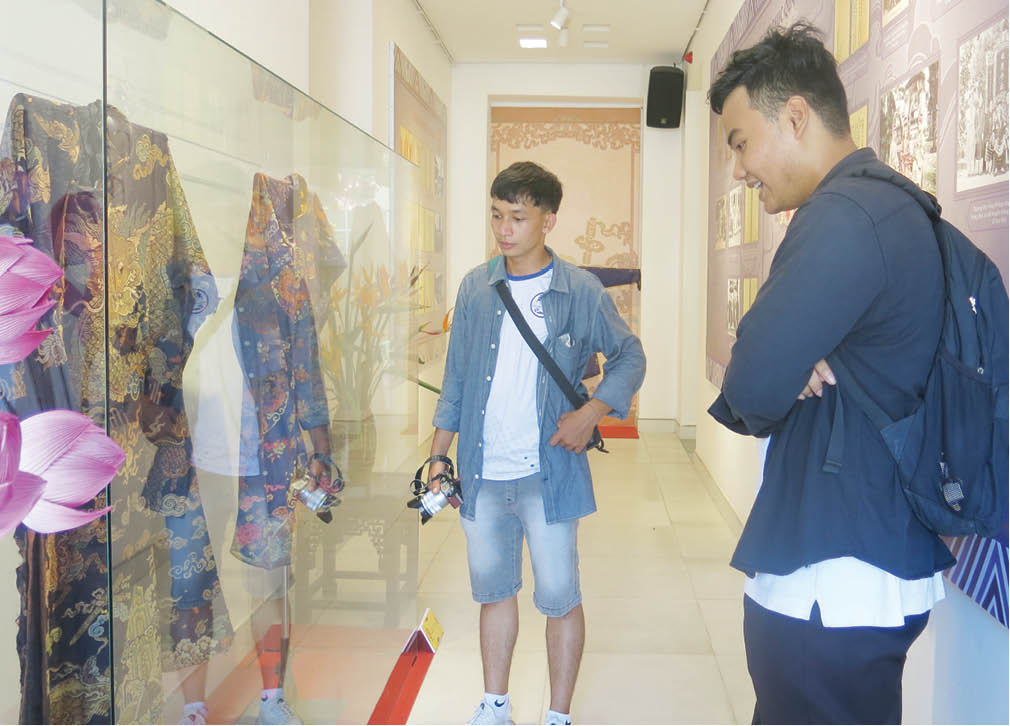
Young people are interested in the costume of the old days
Watching costumes for kings and mandarins
With more than 120 replicas including documents and photos about the costumes for the royal family, mandarins, warriors, graduates, etc., the exhibition brings the viewer an overview of the costume for the last dynasty of Vietnam with strict regulations. Many documents are displayed for the first time.
In addition to the documents kept by the National Archive 1, the viewer can admire robes for kings, queens and mandarins collected by Nguyen Huu Hoang.
“Each costume is really a piece of art which shows the dignity and majesty of a dynasty,” said Le Anh, student from Graphic Design Department, Danang University of Architecture with excitement.

Costume for first-rank imperial guards
The royal costume of the Nguyen dynasty represents the culture and fine art of the country at the time. All the costumes including robes, pants, hats, shoes, etc., abide by hierarchy and functions. Costume for big court events, costume for ordinary court events, costume for ceremonies, costume for everyday use, etc., differ in material, color, style, and decorative patterns.
According to Ms. Dinh Thi Hoai Trai, Director of Hue Museum of Fine Arts, in terms of fine art, each costume for kings, queens, princes, princesses, mandarins, etc., is a work of art. It is the combination of sewing, embroidery, painting and jewelry. Watching them, the viewer can better understand the skills and the taste in aesthetics of ancient artisans. It is therefore essential to preserve and promote the costume of the Nguyen dynasty.
Having collected costumes of the Nguyen dynasty for more than 20 years now, Nguyen Huu Hoang presently owns a collection of about 30 pieces. The collection is not big, but diverse including the costume for kings, mandarins, empress dowagers, maidens, especially the robes for first-rank mandarins and first-rank warrior are unique.
“I collaborate with Hue Museum of Fine Arts to introduce my collection for the public to admire and for researchers and designers to research. Exhibits of these types are few,” said Hoang.
Strictly-regulated costume
According to Dr. Phan Thanh Hai, Director of the Department of Culture and Sports, costume is an important factor of each monarchy. In the East, the civilization of a dynasty is judged also by its costume and ritual music. The monarchies in Vietnam paid special attention to that criterion. In the Nguyen’s era, the costume was considered even more important with a very good foundation starting from the Nguyen Lords’ era and succeeded by the Nguyen kings.
From the Minh Mang’s era onwards, costumes for different ranks were strictly regulated for different occasions, which showed a society of hierarchy and discipline. Looking at someone’s costume, one could tell the majesty of the dynasty and his position in the society.
Each costume for mandarins and aristocrats was the combination of sewing, embroidery, painting and jewelry. The costume of the Nguyen’s era represents history and culture and is a unique heritage of Vietnam.
There were different costumes for different ranks in the Nguyen’s era including the difference in material, color, style, pattern, and accessories.
The royal costume was of various types with their own names, colors, functions and it was worn on specific occasions. There were costume for special events and regular events, costume for rituals and for everyday use, costume for different seasons. Kings and their relatives wore costumes made of first-class silk. In order to enhance their values, gold, silk, diamonds and pearls were attached on top of hats.
In the Nguyen’s era, ranks for mandarins were distinguished by colors and patterns on the costume including belts and hats; warriors by costumes and hats. That distinction proved the hierarchy and social disciplines as well.
The exhibition “Costume in the Nguyen Dynasty” is even more significant when Thua Thien Hue is trying to fulfill the project “Hue_the Capital of Ao dai Vietnam.”
“The exhibition proves Hue was once the kingdom of ao dai, the typical costume of Vietnam. It is the foundation for the success of the project “Hue_ the Capital of Ao dai Vietnam.” That is not only a story about culture but a story of economy development, especially tourism and services from Ao dai products as well,” stressed Hai.
Story and photos: MINH HIEN